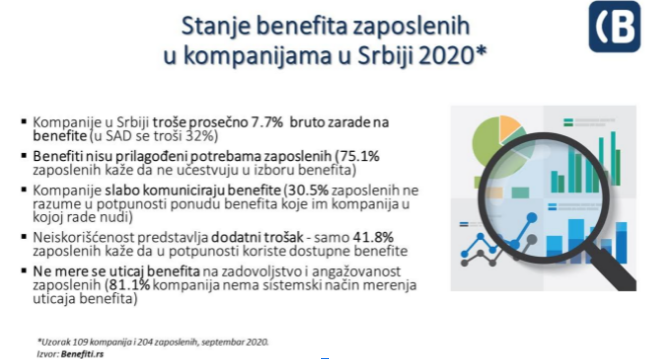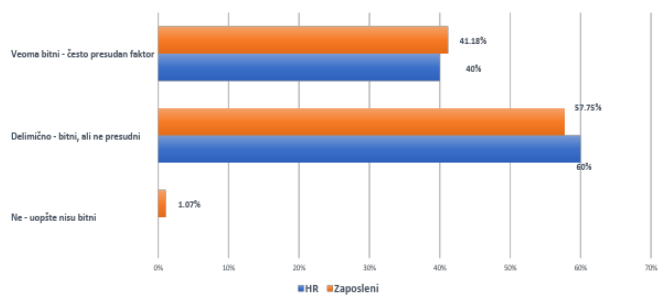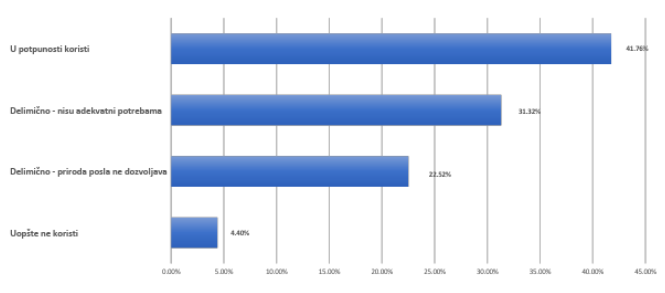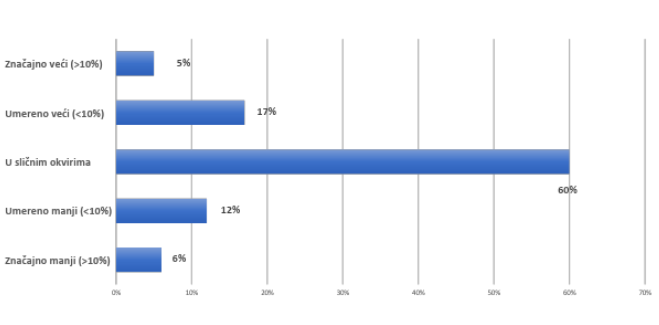In an effort to learn firsthand what the biggest challenges are in providing benefits to employees in companies in Serbia, we conducted a study titled “The State of Employee Benefits in Companies in Serbia” in September 2020, the key results of which we share with you in this text.
Through a questionnaire and face-to-face interviews, we surveyed 109 representatives of companies operating in Serbia on one side and 204 employees on the other, which helped us view the key challenges from both perspectives. In the companies, we mostly spoke with HR and Comp&Ben managers who are directly involved in the process of creating and implementing employee benefit programs.
We made an effort to ensure that the sample is representative in terms of industries and company sizes, so we included 21 companies from the segment of small and micro companies (up to 50 employees), 44 companies from the medium segment (51 to 250 employees), and we also spoke with 21 representatives from companies with 250 to 1,000 employees, as well as with 23 representatives from companies employing more than 1,000 employees.
Among the industries, the most represented is IT (36 companies), followed by: manufacturing (11 companies), retail/FMCG (10), finance and banking (10), telecommunications (9), pharmaceuticals and healthcare (9), consulting and professional services (8), etc.
Regarding the sample of employees, we also paid attention to representativeness based on criteria such as salary levels, seniority, and the age of the respondents.
It is important to note that the research was conducted in September 2020, so it took into account the changes in the area of providing benefits to employees caused by the COVID-19 pandemic.
Key Insights
Although companies invest significant resources in employee benefits (7.69% of gross salary), the benefits are not tailored to the individual needs of employees - 75.1% of employees said they do not participate in the selection of benefits, and 30.5% reported that they do not have a clear picture of what benefits are actually offered by the company they work for. The underutilization of benefits represents an additional cost for the company - only 41.8% of employees say they fully utilize the available benefits (in other words, nearly 60% of employees fail to fully take advantage of them). Moreover, 81.1% of surveyed HR representatives say they do not have a systematic approach to measuring the effects of benefits, or their actual impact on employee engagement, satisfaction, motivation, and retention.
We already intuitively knew and expected this information, but the great value of the research lies in the fact that everything has been validated and quantified through a methodological study.

The Importance of Benefits
It is clear that benefits are not the most important factor when we talk about employee motivation and retention. According to the annual global survey by Manpower Group, depending on age category, specialization, seniority, and industry, benefits rank between 4th and 6th place on the priority list of factors influencing employee motivation and retention.
According to our research, 41.18% of employees and 40% of HR and Comp&Ben managers believe that benefits are a very important, often crucial factor for candidates when choosing a new employer, while 57.75% of employees and 60% of HR managers consider them important, but not a decisive factor.

Adaptability of Benefits to Employee Needs
The key challenge with benefits at this time is the ability of companies to tailor them to each individual employee.
First of all, it is important to highlight that 30.48% of employees say they do not fully understand what benefits their company offers, which suggests that there is insufficient internal communication within organizations regarding benefits. Additionally, 75.09% of employees say they do not have the opportunity to participate in the selection of benefits that their company offers.
Finally, when we talk about how tailored the benefits offered by the company are to their needs, on a scale from 1 to 5, where 1 represents "one size fits all," meaning completely non-personalized benefits, 28.8% of employees gave the lowest rating to their employer in this segment, which is also agreed upon by 17% of HR managers.
Generally speaking, the average rating for the level of customization of benefits given by employees is 2.56, while HR managers rated it slightly higher (2.77 on a scale from 1 to 5).

Utilization of Benefits
One of the results of the research is that "only" 41.76% of employees fully manage to utilize the benefits provided by the company they work for. In other words, nearly 60% of employees do not fully take advantage of what their company has provided and often paid for. 31.32% of them say they do not use all the available benefits because they are not tailored to their needs, and 25.52% say that the nature of their work does not allow them to fully utilize the available benefits. 4.4% say they do not use any benefits at all.

Systematic Approach to Measuring the Effects of Benefits
A modest 18.87% of HR and Comp&Ben managers say that there is a systematic approach in their companies to measuring the impact of benefits on employee satisfaction, and to a large extent, this is part of the annual Employee Satisfaction Survey, in which questions about benefits are only a minor area being assessed.
Remote Benefits
"Remote benefits" are all those benefits for which the user (employee) can be located anywhere. Some examples include: online coaching, online education (trainings, workshops), assessments, online psychologists and psychotherapists, telemedicine (consultations with doctors), online fitness (working with a trainer, Pilates, yoga...), streaming services, online learning platforms, mindfulness applications, online education for employees' children, virtual assistants, financial counseling, food delivery, and other necessities, etc.
51% of companies stated that during the early waves of the pandemic (spring and summer), they included this type of benefit in their offerings.
Share of Benefits in Earnings
On average, companies allocate a significant 7.69% of their salary budget for benefits.
The majority of companies allocate between 5% and 10%—39% of them; less than 5% is allocated by 38% of companies, while 14.63% of companies invest between 10% and 15% in employee benefits. Between 15% and 20%, 7.32% of companies invest in employee benefits.
For comparison, in the USA, companies allocate about 32% of the gross earnings of their employees for the same purpose (2018 EMPLOYEE BENEFITS, The Evolution of Benefits).
Budget Projection for Benefits for 2021
The perspective of HR and Comp&Ben managers regarding the budget for benefits launched for 2021 was interesting.
To a large extent (60%), company representatives believed that the benefit budget for 2021 would be similar to that of the previous year.
As many as 17% predicted 17% of this budget, while 5% expected a significant increase in the budget (over 10%).
Among the more pessimistic group, which predicted a decrease in the budget for benefits, 12% of companies expected moderate reductions (up to 10%), while 6% of companies expected significant reductions (more than 10%).

In Conclusion
The results of the 2020 research confirmed the assumptions on which the Benefiti.app platform was created, as well as the results of our preliminary research from May and June 2019.
With this 2020 research, we aimed to methodologically validate the previous knowledge we gained during the development process of our platform. It has been shown once again that employee benefits in Serbia are indeed important to both employees and companies (57.75% of employees and 60% of HR managers see them as an important factor in choosing an employer), as well as that a significant portion of company funds is spent on them (7.69% of gross earnings).
However, the main challenge arises from the conclusion that employees are not consulted about what benefits they want to use (75.1%), and in 30.5% of cases, they do not even know what benefits their company offers. The situation is further complicated by the fact that although companies spend significant funds on benefits, 60% of employees fail to fully utilize available benefits. This lack of personalization and the "one-size-fits-all" approach motivated us to launch the Benefiti.app platform, which allows each employee to choose benefits according to their needs while still being within the budget defined by the employer.
By providing benefits, companies aim to show additional care for their employees and a desire to further motivate them, thus reducing employee turnover. In practice, it has been shown that benefits can influence employee motivation and loyalty to the company. However, the fact is that most companies do not have a systematic approach to measuring the impact of benefits (81.1% of surveyed HR professionals confirm this), meaning they do not know to what extent and which specific benefits affect motivation, so the company does not have a true insight into the importance of benefits for their employees.
The Benefiti.app platform tackles all these challenges, aiming to enable companies to systematically measure the impact of benefits on employee satisfaction and motivation, while allowing employees to truly receive what they want: benefits they choose and can change on a monthly basis.
Schedule your demo session through calendly or write to us at info@benefiti.rs to learn more about the personalized employee benefits platform.